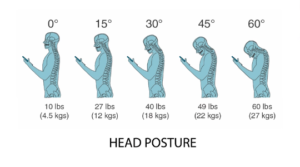In Australia, chronic pain affects 1 in 5 people and in 2018 this cost the economy $139 Billion in associated lost workdays and healthcare.1
Forward head posture is a contributor to this as poor head posture can become a chronic postural issue over time, causing symptoms such as pain and stiffness in the neck and back.
It’s therefore important to consider your head posture and its impact on your wellbeing.
What are the causes of forward head posture
Some potential causes of poor head posture include:
- use of technology
- slouching, especially while sitting for prolonged periods
- sleep position
- reading in bed
- carrying a heavy backpack or purse
- hunching your back while driving
- blocked sinuses (that lead to mouth breathing instead of nose breathing)
- whiplash or other injuries to the spine weakness in the muscles of the upper back
- arthritis and bone degeneration
Is there anything you can do to prevent poor head posture?
Below are some simple solutions to consider to address some of the common contributors to forward head posture and hopefully prevent it from becoming a chronic problem.
1. Bring awareness to your head posture
Millions of years ago, standing on two feet and balancing our head on our spine posed some significant challenges to our posture, and the balance of muscles in and around our head, neck and spine.
The role of technology is becoming an increasingly significant problem on many levels; bad posture creates a strain on the muscles of your head and neck. If you suffer from chronic tension headaches and neck aches, the use of technology with a forward head posture could be making it worse.
The first step toward fixing a problem is to become aware of it. Ask yourself a few questions;
- how long do you spend at your desk?
- how have you set up your desk?
- what is your normal position when holding a device?
- how long are you spending on these devices each day?
By asking these questions, you can at least bring awareness to your head position. From there, start to consider whether there is an issue and how you might start to address the problem.
One of the most important environmental changes influencing human physiology and disease in recent years has been the decline of physical activity that was a routine part of most people’s lives.
2. Review and reduce sitting and sedentary time
Nearly half (49.4%) of employed people aged 18-64 years described their day at work as mostly sitting2
Sitting provides a perfect example of just how far-reaching the health repercussions of bad posture can be.
Our modern daily life sees many of us, including our children, spending far too much time sedentary – sitting at jobs, schools or partaking in ‘leisure’ activities that promote poor posture.
According to research the biggest difference between people of average weight and those who are overweight isn’t related to diet or exercise, but to the amount of time they are seated.2 This is because of an enzyme called lipoprotein lipase, found in the cells that line the tiny blood vessels of muscles and in fatty tissue, where it plays a critical role in the breakdown of fat.
When you stand, the postural muscles that support your weight — mostly in your legs — release this enzyme, which helps burn fat. But when you sit still and don’t shift every 30 to 90 seconds, as the body is inclined to do naturally, the fat remains in the arteries and can be stored as body fat. Studies have shown that a typical day of sitting lowers lipoprotein-lipase activity in animals by 90-95 per cent3, an effect that could be similar in humans.
When we are sitting, there are no muscle contractions and it’s those muscle contractions that help the body’s efficiency to clear blood sugar levels and blood-fat levels. It’s known that elevated glucose levels can lead to inflammation, which is repeated for hours, days or weeks and can lead to heart disease and a host of other conditions, such as cancer. Elevated glucose levels are implicated in almost every chronic disease.
All that is required is to incorporate movement throughout the day. A gentle walk for two minutes every 20 minutes can lower blood glucose levels by around 30 per cent. We are simply sitting for too long and if we think a 30-60-minute workout followed by 12-16 hours, or more, of sitting is OK we are kidding ourselves.
It must be said that it is often hard for many of us to avoid sitting altogether. Therefore an important and simple preventative measure is to set up your desk well.
3. Set up your workspace ergonomically
When you spend most of the day sitting in a chair and looking at a screen, it’s simple to hunch your head forwards. As we’ve already discussed moving your body periodically throughout the day, setting up your workspace is another key preventative measure.
Set up your workspace so that it encourages you to maintain a straight line from your shoulders to your head.
Here are some quick simple steps to take for an optimal set-up:
- raise the computer screen so that when you stare straight ahead, your eyes will land in the top third of the display
- place your keyboard and mouse such that when you use them, your elbows will be roughly 90 degrees bent and your forearms parallel to the floor
- keep the mouse nearby and use a mouse pad with a wrist pad and have objects within easy reach
- adjusting the chair to support the lower back and ensure that the knees are a bit lower than the hips
- place your feet flat on the floor
- if you can, purchase an office chair with a headrest so you can work with your back flush against the chair
- explore the benefits of a sit/stand desk
4. Correct your head posture when using devices
Other researchers have measured the impact of the typical posture when writing a text message on a phone.
The weight of the average adult’s head is between four and five kilograms, but when it is tilted forward its effective weight increases, placing greater pressure on the neck.

For example, a 30-degree tilt of the head is the equivalent of holding 18 kilograms of weight4, a significant increase. As you can imagine, this increase drastically increases the load through the muscles of the head and neck and down your back. Postural stress is a significant stressor that impacts your health and wellbeing and is something we should aim to minimise.
As you travel on a bus or train or even just walk down a street, take a look around; you’ll probably notice the vast majority of people have their heads down looking at their phones or other digital devices. The implications of this imbalance are potentially widespread among young and old.
This exaggerated yet common head posture may also be exacerbating some chronic musculoskeletal pain conditions which literally cost billions of dollars a year. There are secondary repercussions as chronic pain is often treated with medication.
The cost of chronic pain
Many people develop chronic or recurrent problems because they receive treatment for the pain (e.g. pain killers or anti-inflammatory medication) but never receive treatment for or address the underlying cause which is their forward head posture.
The National Drug and Alcohol Research Centre’s (NDARC) Professor Louisa Degenhardt explains “It is concerning that people are being prescribed opioid medications for chronic pain when there is little evidence that opioids are effective for these conditions”5.
Over the financial year 2015-16, extra-medical opioid use came at a cost of an estimated $15.7 billion.5
In the case of head posture and its impact on chronic pain; movement is the key as well as less time on electronic devices, reviewing how much time you’re sitting down and setting up your workstation ergonomically.
Addressing the root cause of these issues is a simple and cheap preventative solution. It doesn’t require equipment or gym memberships and is good for every measure of health. We explore postural stress and its’ implications in a number of our deep dive pillars of health programs.
References
- Painaustralia and Deloitte Access Economics. Accessed on The Pain Foundation, July 2022.
- Australian Bureau of Statistics (2021), National Health Survey 2020-21. Accessed here.
- Bey L, Hamilton MT. Suppression of skeletal muscle lipoprotein lipase activity during physical inactivity: a molecular reason to maintain daily low-intensity activity. J Physiol. 2003 Sep 1;551(Pt 2):673-82. doi: 10.1113/jphysiol.2003.045591. Epub 2003 Jun 18. PMID: 12815182; PMCID: PMC2343229.
- Hansraj KK. Assessment of stresses in the cervical spine caused by posture and position of the head. Surg Technol Int. 2014 Nov;25:277-9. PMID: 25393825.
- National Drug Research Institute, Curtin University





